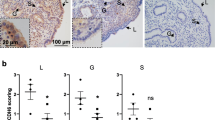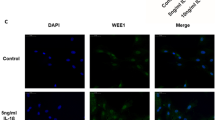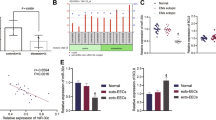Abstract
Purpose
E-cadherin, a transmembrane glycoprotein mediating Ca2+-independent homotypic cell–cell adhesion in epithelial cell, plays an essential role in metastasis. It has been postulated that E-cadherin downregulation is a crucial mechanism in the pathogenesis of endometriosis. To evaluate the effect on the cell behavior after knockdown of E-cadherin gene (CDH1) in cultured human endometrial epithelial cells (EECs) isolated from normal endometrium.
Methods
EECs were isolated from the endometrial tissues of fertile woman who underwent total hysterectomy due to cervical intraepithelial neoplasia III. CDH1 expression was knocked down by small hairpin RNA. The EECs transfected with empty vector served as control. Transwell assay was used to test EECs migration or invasion. qRT-PCR and western blot were used to detect mRNA and protein levels.
Results
The results showed that knockdown of E-cadherin expression can increase cell migration and invasion, and up-regulate mRNA and protein levels of β-catenin, cyclinD1, and c-myc.
Conclusions
Down-regulation of E-cadherin expression may activate the Wnt/β-catenin pathway in endometrial cells, which may together participate in the occurrence of endometriosis.




Similar content being viewed by others
References
Sampson JA (1927) Peritoneal endometriosis due to menstrual dissemination of endometrial tissue into peritoneal cavity. Am J Obstet Gynecol 14:422–469
Shimoyama Y, Hirohashi S, Hirano S, Noguchi M, Shimosato Y, Takeichi M, Abe O (1989) Cadherin cell-adhesion molecules in human epithelial tissues and carcinomas. Can Res 49:2128–2133
Thiery JP (2002) Epithelial–mesenchymal transitions in tumour progression. Nat Rev Cancer 2:442–454
Hay ED (1995) An overview of epithelio-mesenchymal transformation. Acta Anat 154:8–20
Gaetje R, Kotzian S, Herrmann G, Baumann R, Starzinski-Powitz A (1997) Nonmalignant epithelial cells, potentially invasive in human endometriosis, lack the tumor suppressor molecule E-cadherin. Am J Pathol 150:461–467
Zeitvogel A, Baumann R, Starzinski-Powitz A (2001) Identification of an invasive, N-cadherin expressing epithelial cell type in endometriosis using a new cell culture model. Am J Pathol 159:1839–1852
Klaus A, Birchmeier W (2008) Wnt signalling and its impact on development and cancer. Nat Rev Cancer 8:387–398
Grigoryan T, Wend P, Klaus A, Birchmeier W (2008) Deciphering the function of canonical Wnt signals in development and disease: conditional loss- and gain-of-function mutations of beta-catenin in mice. Genes Dev 22:2308–2341
Nelson WJ, Nusse R (2004) Convergence of Wnt, beta-catenin and cadherin pathways. Science 303:1483–1487
Giudice LC, Kao LC (2004) Endometriosis. Lancet 364:1789–1799
Matsuzaki S, Darcha C (2012) Epithelial to mesenchymal transition-like and mesenchymal to epithelial transition-like processes might be involved in the pathogenesis of pelvic endometriosis. Hum Reprod 27:712–721
de Mattos RM, Pereira PR, Barros EG, da Silva JH, Palmero CY, da Costa NM, Pinto LF, Gimba ER, Hecht F, Ferreira LB, Machado DE, de Oliveira FL, Nasciutti LE (2016) Aberrant levels of Wnt/β-catenin pathway components in a rat model of endometriosis. Histol Histopathol 31(8):933–942
Matsuzaki S, Botchorishvili R, Pouly JL, Canis M (2014) Targeting the Wnt/β-catenin pathway in endometriosis: a potentially effective approach for treatment and prevention. Mol Cell Ther 2:36
Chen YJ, Li HY, Huang CH, Twu NF, Yen MS, Wang PH, Chou TY, Liu YN, Chao KC, Yang MH (2010) Oestrogen-induced epithelial–mesenchymal transition of endometrial epithelial cells contributes to the development of adenomyosis. J Pathol 222(3):261–270
Scotti S, Regidor PA, Schindler AE, Winterhager E (2000) Reduced proliferation and cell adhesion in endometriosis. Mol Hum Reprod 6(7):610–617
Poncelet C, Leblanc M, Walker-Combrouze F, Soriano D, Feldmann G, Madelenat P, Scoazec JY, Daraï E (2002) Expression of cadherins and CD44 isoforms in human endometrium and peritoneal endometriosis. Acta Obstet Gynecol Scand 81(3):195–203
Bartley J, Julicher A, Hotz B, Mechsner S, Hotz H (2014) Epithelial to mesenchymal transition (EMT) seems to be regulated differently in endometriosis and the endometrium. Arch Gynecol Obstet 289(4):871–881
Drees F, Pokutta S, Yamada S, Nelson WJ, Weis WI (2005) Alpha-catenin is a molecular switch that binds E-cadherin–beta-catenin and regulates actinfilament assembly. Cell 123:903–915
Yamada S, Pokutta S, Drees F, Weis WI, Nelson WJ (2005) Deconstructing the cadherin–catenin–actin complex. Cell 123:889–901
Kemler R, Hierholzer A, Kanzler B, Kuppig S, Hansen K, Taketo MM, de Vries WN, Knowles BB, Solter D (2004) Stabilization of β-catenin in the mouse zygote leads to premature epithelial–mesenchymal transition in the epiblast. Development 131:5817–5824
Barker N, Clevers H (2006) Mining the Wnt pathway for cancer therapeutics. Nat Rev Drug Discov 5(12):997–1014
He TC, Sparks AB, Rago C, Hermeking H, Zawel L, da Costa LT, Morin PJ, Vogelstein B, Kinzler KW (1998) Identification of c-MYC as a target of the APC pathway. Science 281:1509–1512
Shtutman M, Zhurinsky J, Simcha I, Albanese C, D’Amico M, Pestell R, Ben-Ze’ev A (1999) The cyclin D1 gene is a target of the beta-catenin/LEF-1 pathway. Proc Natl Acad Sci USA 96:5522–5527
de Mattos RM, Pereira PR, Barros EG, da Silva JH, Palmero CY, da Costa NM, Pinto LF, Gimba ER, Hecht F, Ferreira LB, Machado DE, de Oliveira FL, Nasciutti LE (2016) Aberrant levels of Wnt/β-catenin pathway components in a rat model of endometriosis. Histol Histopathol 31(8):933–942
Matsuzaki S, Darcha C (2013) In vitro effects of a small-molecule antagonist of the Tcf/β-catenin complex on endometrial and endometriotic cells of patients with endometriosis. PLoS One 8:e61690
Author information
Authors and Affiliations
Contributions
SK: Protocol development. YL: Protocol development and manuscript writing. XZ: Performed the experiments and manuscript writing. RZ: Data analysis. NW: Data analysis.
Corresponding author
Ethics declarations
Ethics approval
This study was approved by Fourth Hospital’s Ethics Committee, Hebei Medical University.
Informed consent
Informed consent was obtained from all recruited subjects.
Conflict of interest
The authors declare that there is no conflict of interest.
Funding
This work was supported by a grant from the National Natural Science Foundation of China (no. 81270673).
Electronic supplementary material
Below is the link to the electronic supplementary material.
Rights and permissions
About this article
Cite this article
Zhu, X., Li, Y., Zhou, R. et al. Knockdown of E-cadherin expression of endometrial epithelial cells may activate Wnt/β-catenin pathway in vitro. Arch Gynecol Obstet 297, 117–123 (2018). https://doi.org/10.1007/s00404-017-4560-0
Received:
Accepted:
Published:
Issue Date:
DOI: https://doi.org/10.1007/s00404-017-4560-0




